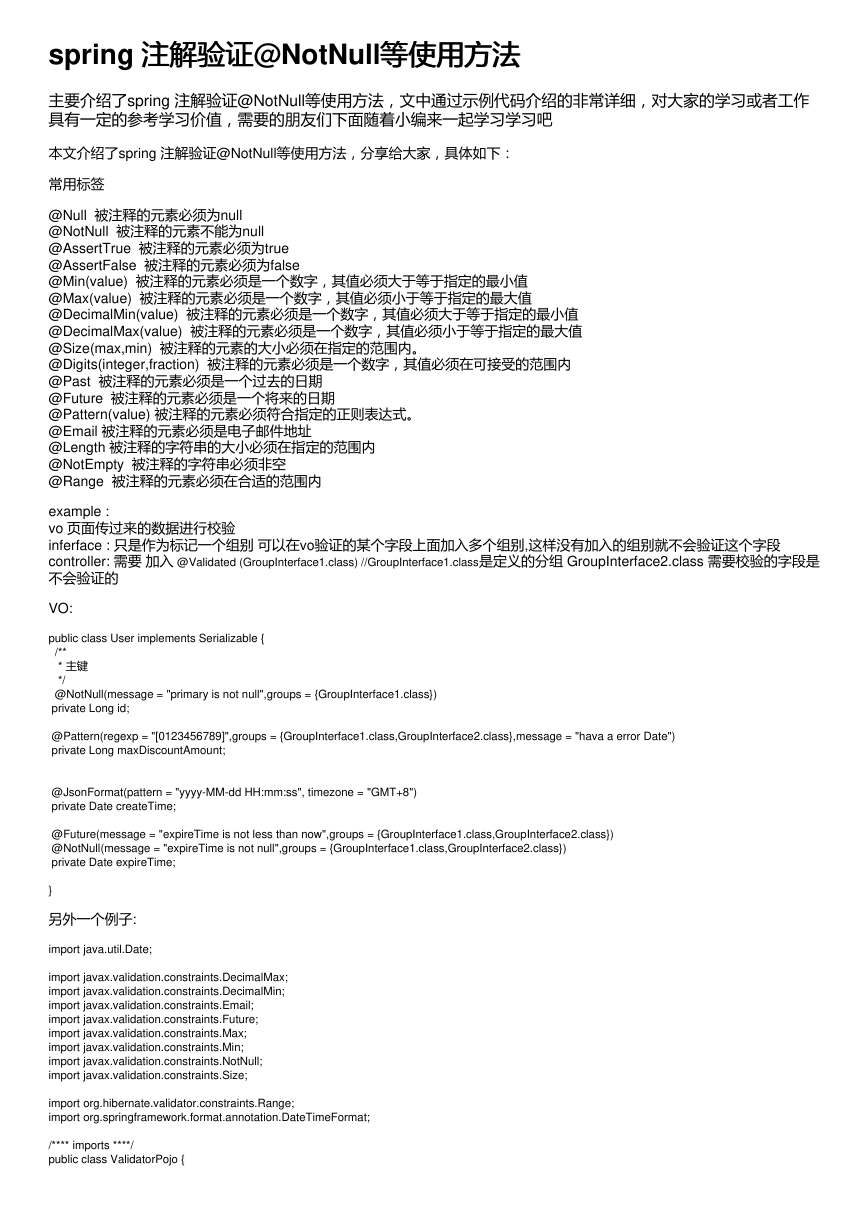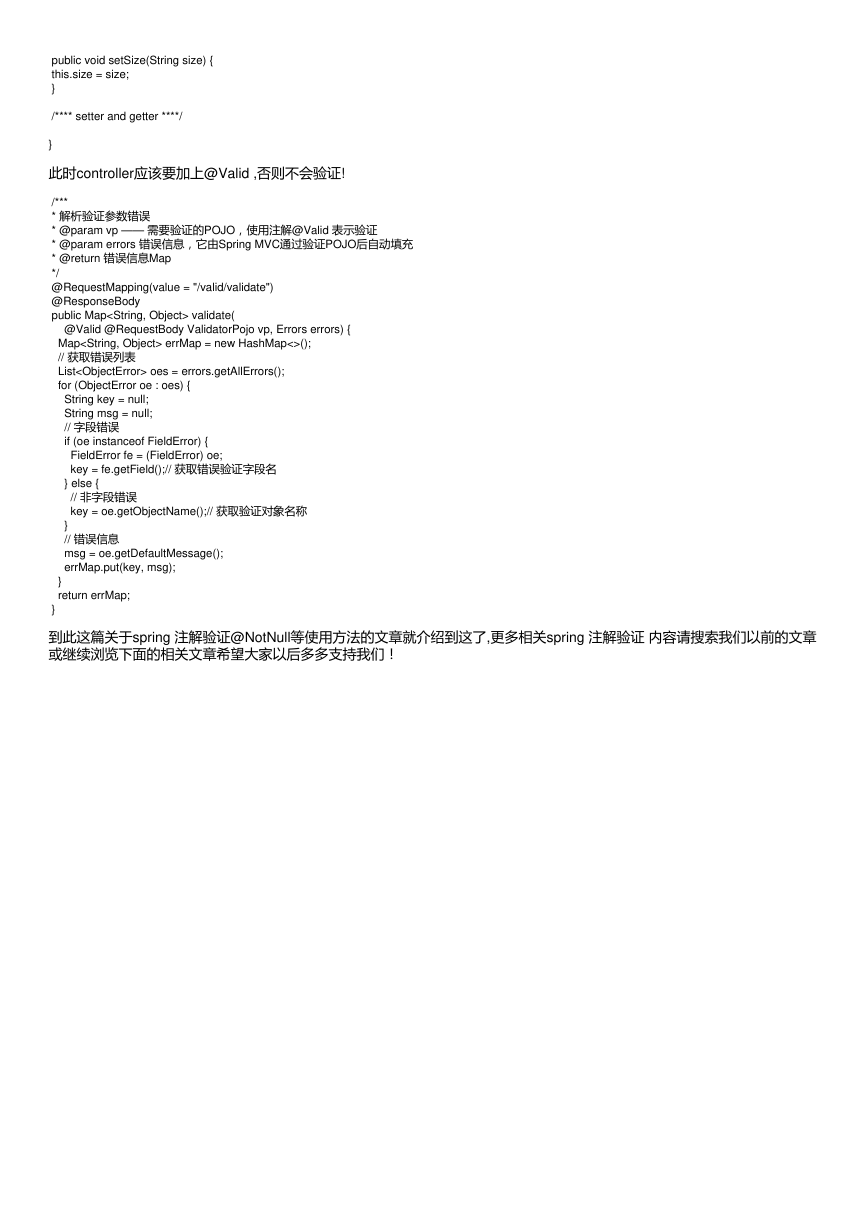注解验证@NotNull等使用方法
等使用方法
spring 注解验证
主要介绍了spring 注解验证@NotNull等使用方法,文中通过示例代码介绍的非常详细,对大家的学习或者工作
具有一定的参考学习价值,需要的朋友们下面随着小编来一起学习学习吧
本文介绍了spring 注解验证@NotNull等使用方法,分享给大家,具体如下:
常用标签
@Null 被注释的元素必须为null
@NotNull 被注释的元素不能为null
@AssertTrue 被注释的元素必须为true
@AssertFalse 被注释的元素必须为false
@Min(value) 被注释的元素必须是一个数字,其值必须大于等于指定的最小值
@Max(value) 被注释的元素必须是一个数字,其值必须小于等于指定的最大值
@DecimalMin(value) 被注释的元素必须是一个数字,其值必须大于等于指定的最小值
@DecimalMax(value) 被注释的元素必须是一个数字,其值必须小于等于指定的最大值
@Size(max,min) 被注释的元素的大小必须在指定的范围内。
@Digits(integer,fraction) 被注释的元素必须是一个数字,其值必须在可接受的范围内
@Past 被注释的元素必须是一个过去的日期
@Future 被注释的元素必须是一个将来的日期
@Pattern(value) 被注释的元素必须符合指定的正则表达式。
@Email 被注释的元素必须是电子邮件地址
@Length 被注释的字符串的大小必须在指定的范围内
@NotEmpty 被注释的字符串必须非空
@Range 被注释的元素必须在合适的范围内
example :
vo 页面传过来的数据进行校验
inferface : 只是作为标记一个组别 可以在vo验证的某个字段上面加入多个组别,这样没有加入的组别就不会验证这个字段
controller: 需要 加入 @Validated (GroupInterface1.class) //GroupInterface1.class是定义的分组 GroupInterface2.class 需要校验的字段是
不会验证的
VO:
public class User implements Serializable {
/**
* 主键
*/
@NotNull(message = "primary is not null",groups = {GroupInterface1.class})
private Long id;
@Pattern(regexp = "[0123456789]",groups = {GroupInterface1.class,GroupInterface2.class},message = "hava a error Date")
private Long maxDiscountAmount;
@JsonFormat(pattern = "yyyy-MM-dd HH:mm:ss", timezone = "GMT+8")
private Date createTime;
@Future(message = "expireTime is not less than now",groups = {GroupInterface1.class,GroupInterface2.class})
@NotNull(message = "expireTime is not null",groups = {GroupInterface1.class,GroupInterface2.class})
private Date expireTime;
}
另外一个例子:
import java.util.Date;
import javax.validation.constraints.DecimalMax;
import javax.validation.constraints.DecimalMin;
import javax.validation.constraints.Email;
import javax.validation.constraints.Future;
import javax.validation.constraints.Max;
import javax.validation.constraints.Min;
import javax.validation.constraints.NotNull;
import javax.validation.constraints.Size;
import org.hibernate.validator.constraints.Range;
import org.springframework.format.annotation.DateTimeFormat;
/**** imports ****/
public class ValidatorPojo {
�
// 非空判断
@NotNull(message = "id不能为空")
private Long id;
@Future(message = "需要一个将来日期") // 只能是将来的日期
// @Past //只能去过去的日期
@DateTimeFormat(pattern = "yyyy-MM-dd") // 日期格式化转换
@NotNull // 不能为空
private Date date;
@NotNull // 不能为空
@DecimalMin(value = "0.1") // 最小值0.1元
@DecimalMax(value = "10000.00") // 最大值10000元
private Double doubleValue = null;
@Min(value = 1, message = "最小值为1") // 最小值为1
@Max(value = 88, message = "最大值为88") // 最大值88
@NotNull // 不能为空
private Integer integer;
@Range(min = 1, max = 888, message = "范围为1至888") // 限定范围
private Long range;
// 邮箱验证
@Email(message = "邮箱格式错误")
private String email;
@Size(min = 20, max = 30, message = "字符串长度要求20到30之间。")
private String size;
public Long getId() {
return id;
}
public void setId(Long id) {
this.id = id;
}
public Date getDate() {
return date;
}
public void setDate(Date date) {
this.date = date;
}
public Double getDoubleValue() {
return doubleValue;
}
public void setDoubleValue(Double doubleValue) {
this.doubleValue = doubleValue;
}
public Integer getInteger() {
return integer;
}
public void setInteger(Integer integer) {
this.integer = integer;
}
public Long getRange() {
return range;
}
public void setRange(Long range) {
this.range = range;
}
public String getEmail() {
return email;
}
public void setEmail(String email) {
this.email = email;
}
public String getSize() {
return size;
}
�
public void setSize(String size) {
this.size = size;
}
/**** setter and getter ****/
}
此时controller应该要加上@Valid ,否则不会验证!
/***
* 解析验证参数错误
* @param vp —— 需要验证的POJO,使用注解@Valid 表示验证
* @param errors 错误信息,它由Spring MVC通过验证POJO后自动填充
* @return 错误信息Map
*/
@RequestMapping(value = "/valid/validate")
@ResponseBody
public Map validate(
@Valid @RequestBody ValidatorPojo vp, Errors errors) {
Map errMap = new HashMap<>();
// 获取错误列表
List oes = errors.getAllErrors();
for (ObjectError oe : oes) {
String key = null;
String msg = null;
// 字段错误
if (oe instanceof FieldError) {
FieldError fe = (FieldError) oe;
key = fe.getField();// 获取错误验证字段名
} else {
// 非字段错误
key = oe.getObjectName();// 获取验证对象名称
}
// 错误信息
msg = oe.getDefaultMessage();
errMap.put(key, msg);
}
return errMap;
}
到此这篇关于spring 注解验证@NotNull等使用方法的文章就介绍到这了,更多相关spring 注解验证 内容请搜索我们以前的文章
或继续浏览下面的相关文章希望大家以后多多支持我们!
�






 2023年江西萍乡中考道德与法治真题及答案.doc
2023年江西萍乡中考道德与法治真题及答案.doc 2012年重庆南川中考生物真题及答案.doc
2012年重庆南川中考生物真题及答案.doc 2013年江西师范大学地理学综合及文艺理论基础考研真题.doc
2013年江西师范大学地理学综合及文艺理论基础考研真题.doc 2020年四川甘孜小升初语文真题及答案I卷.doc
2020年四川甘孜小升初语文真题及答案I卷.doc 2020年注册岩土工程师专业基础考试真题及答案.doc
2020年注册岩土工程师专业基础考试真题及答案.doc 2023-2024学年福建省厦门市九年级上学期数学月考试题及答案.doc
2023-2024学年福建省厦门市九年级上学期数学月考试题及答案.doc 2021-2022学年辽宁省沈阳市大东区九年级上学期语文期末试题及答案.doc
2021-2022学年辽宁省沈阳市大东区九年级上学期语文期末试题及答案.doc 2022-2023学年北京东城区初三第一学期物理期末试卷及答案.doc
2022-2023学年北京东城区初三第一学期物理期末试卷及答案.doc 2018上半年江西教师资格初中地理学科知识与教学能力真题及答案.doc
2018上半年江西教师资格初中地理学科知识与教学能力真题及答案.doc 2012年河北国家公务员申论考试真题及答案-省级.doc
2012年河北国家公务员申论考试真题及答案-省级.doc 2020-2021学年江苏省扬州市江都区邵樊片九年级上学期数学第一次质量检测试题及答案.doc
2020-2021学年江苏省扬州市江都区邵樊片九年级上学期数学第一次质量检测试题及答案.doc 2022下半年黑龙江教师资格证中学综合素质真题及答案.doc
2022下半年黑龙江教师资格证中学综合素质真题及答案.doc